Uncategorized
Crypto for Advisors: 2025 Outlook

In today’s issue, Leo Mindyuk from MLTech provides a crypto outlook for 2025 and highlights key factors that could drive the adoption of these assets.
Then, Miguel Kudry from L1 Advisors shares his insights on the topic in Ask and Expert.
You’re reading Crypto for Advisors, CoinDesk’s weekly newsletter that unpacks digital assets for financial advisors. Subscribe here to get it every Thursday.
2025 Outlook for Crypto Adoption: Building Bridges to the Mainstream
The crypto industry is entering 2025 with a renewed sense of purpose. Over the past year, the sector has witnessed key developments that signal crypto’s increasing integration into traditional finance (TradFi) and broader adoption of crypto assets, especially bitcoin. However, the road ahead will test the resilience of this growing ecosystem. As we assess the outlook for 2025, several factors emerge as critical to shaping the adoption trajectory: regulatory clarity, institutional participation, and technological innovation.
1. Regulatory Clarity: Turning Uncertainty Into Institutional Guidelines
As I’ve briefly discussed on my CoinDesk podcast about election night results and the price action around it, regulatory clarity is emerging as a pivotal factor for crypto adoption. The market has already started pricing in the expectation that newly elected officials will bring long-awaited structure to the digital asset ecosystem. We will see some of those expectations starting to play out this year. Key areas where we are likely to see more clarity include:
a) Definition and classification of digital assets: The U.S. is expected to refine how digital assets are classified — whether as securities, commodities, or some combination. This clarity will directly impact how tokens are issued, traded, regulated, and taxed.
b) Stablecoins: These are likely to be a major focus for regulators due to their transformative real-world use cases and potential impact on financial stability.
c) Taxation of crypto transactions: Recent changes have already been made, and we will likely see clearer tax reporting requirements for digital assets, various associated activities, and various industry players.
Additional topics such as tokenization—including real-world assets—custodial and non-custodial wallets, regulated trading venues, decentralized finance (DeFi), anti-money laundering (AML) and know your customer (KYC) compliance, and consumer protections will also be actively discussed and potentially acted upon.
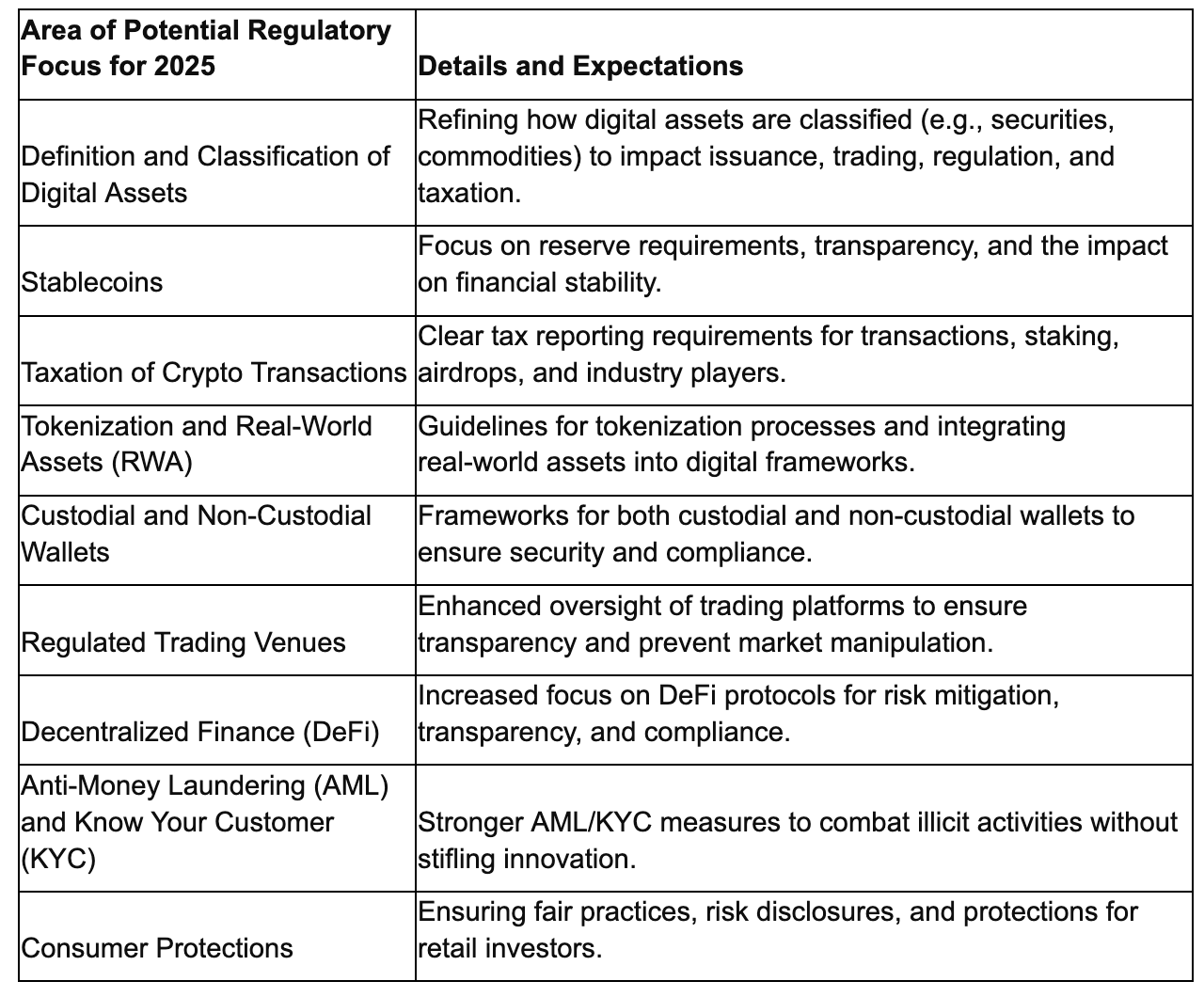
2. Institutional Participation: ETFs as a Catalyst
In 2024, crypto ETFs experienced explosive growth, with billions in net inflows and notable launches. With new products, crypto ETFs now represent a rapidly expanding financial market segment, attracting significant investor interest and outperforming traditional funds. We will likely see a variety of adjacent products.
For 2025, growing inflows and high volumes in BTC and ETH ETFs will likely continue to validate crypto as an asset class and streamline access for retail and institutional investors. This will open the path for other single-asset ETFs, multi-asset ETFs, and various adjacent ETFs (e.g., leveraged, inverse, market-timing, volatility). If regulatory clarity progresses fast enough, we may see the U.S.’s first crypto yield-generating ETFs (e.g., staking). These products could bring additional investor interest to the asset class and increase inflows into passive and active investment products.
3. Technological Innovation: The Convergence of Blockchain Scalability and AI
Technological advancements in 2025 will be driven by Layer-2 blockchain scalability and AI integration. Rollups, zero-knowledge proofs, and interoperability will enhance transaction efficiency and user experience for decentralized applications (dApps) and DeFi. Simultaneously, AI agents operating on decentralized networks will solve and optimize a variety of tasks and interact with users and each other. This synergy simplifies Web3 interactions and ensures secure, transparent execution of AI decisions on blockchain. Together, these innovations will lower barriers to entry, attract developers and users, and accelerate mainstream adoption, making 2025 a pivotal year for blockchain and AI convergence.
Summary
The outlook for crypto adoption in 2025 is overwhelmingly positive, but not without challenges. Regulatory clarity, institutional participation, and technological innovation will be the pillars of growth. The question isn’t whether crypto will gain mainstream acceptance—it’s how fast and in what form. As we approach this next phase, those who adapt to the evolving landscape will lead the charge in shaping the future.
Ask an Expert
Q. What were the most impactful developments in the crypto market over the past year, and how have they shaped crypto adoption?
The most significant development in crypto last year was the political shift, with President-elect Donald Trump making crypto a key part of his platform. Markets are only beginning to price in the impact of the Executive and Legislative branches, along with financial regulators, that not only refrained from fighting the crypto industry but also encouraged crypto innovation within the United States. Beyond bitcoin adoption and the potential establishment of a national strategic bitcoin reserve, the broader implications for financial markets are still unclear to many market participants. Some of the world’s largest financial institutions that were previously on the sidelines are now actively developing their crypto strategy in response to the new pro-crypto administration.
Q. How is the evolving regulatory landscape likely to impact crypto markets and institutional involvement in 2025?
The SEC’s regulation-by-enforcement approach has had a far-reaching impact on the crypto markets. A shift to a neutral — or even positive — stance means financial professionals and institutions will need to actively explore how to better serve their customers who are already engaged with crypto, particularly given its decisive role in the election. Additionally, they will need to adapt their offerings to remain competitive in a world where financial markets and assets increasingly operate on crypto rails. Financial advisors, in particular, now have more opportunities to serve their clients by incorporating crypto allocations and existing crypto portfolios into comprehensive financial planning and strategy.
Q. Given the macroeconomic climate, how should financial professionals think about integrating crypto into broader investment strategies in 2025?
The year 2025 will mark a pivotal shift for crypto, transitioning from merely being an asset class to becoming the infrastructure that underpins a growing portion of all asset classes. Put differently, with the adoption of crypto rails, financial professionals will be better equipped to respond to the macroeconomic climate, further accelerating the flywheel of asset tokenization, portfolio allocations, and broader adoption.
— Miguel Kudry, CEO, L1 Advisors
Keep Reading
J.P. Morgan’s retail platform E-Trade is considering adding crypto trading.
The SEC lawsuit against Coinbase has been paused and is moving to the second circuit.
Czech National Bank opens up discussions around bitcoin as they consider reserve diversification options.
Uncategorized
AI, Mining News: GPU Gold Rush: Why Bitcoin Miners Are Powering AI’s Expansion

When Core Scientific signed a $3.5 billion deal to host artificial intelligence (AI) data centers earlier this year, it wasn’t chasing the next crypto token — it was chasing a steadier paycheck. Once known for its vast fleets of bitcoin mining rigs, the company is now part of a growing trend: converting energy-intensive mining operations into high-performance AI facilities.
Bitcoin miners like Core, Hut 8 (HUT) and TeraWulf (WULF) are swapping ASIC machines — the dedicated bitcoin mining computer — for GPU clusters, driven by the lure of AI’s explosive growth and the harsh economics of crypto mining.
Power play
It’s no secret that bitcoin mining requires an extensive amount of energy, which is the biggest cost of minting a new digital asset.
Back in the 2021 bull run, when the Bitcoin network’s hashrate and difficulty were low, miners were making out like bandits with margins as much as 90%. Then came the brutal crypto winter and the halving event, which slashed the mining reward in half. In 2025, with surging hashrate and energy prices, miners are now struggling to survive with razor-thin margins.
However, the need for power—the biggest input cost—became a blessing in disguise for these miners, who needed a different strategy to diversify their revenue sources.
Due to rising competition for mining, the miners continued to procure more machines to stay afloat, and with it came the need for more megawatts of electricity at a cheaper price. Miners invested heavily in securing these low-cost energy sources, such as hydroelectric or stranded natural gas sites, and developed expertise in managing high-density cooling and electrical systems—skills honed during the crypto boom of the early 2020s.
This is what captured the attention of AI and cloud computing firms. While bitcoin relies on specialized ASICs, AI thrives on versatile GPUs like Nvidia’s H100 series, which require similar high-power environments but for parallel processing tasks in machine learning. Instead of building out data centers from scratch, taking over mining infrastructure, which already has power ready, became a faster way to grow an increasing appetite for AI-related infrastructure.
Essentially, these miners aren’t just pivoting—they’re retrofitting.
The cooling systems, low-cost energy contracts, and power-dense infrastructure they built during the crypto boom now serve a new purpose: feeding the AI models of companies like OpenAI and Google.
Firms like Crusoe Energy sold off mining assets to focus solely on AI, deploying GPU clusters in remote, energy-rich locations that mirror the decentralized ethos of crypto but now fuel centralized AI hyperscalers.
Terraforming AI
Bitcoin mining has effectively «terraformed» the terrain for AI compute by building out scalable, power-efficient infrastructure that AI desperately needs.
As Nicholas Gregory, Board Director at Fragrant Prosperity, noted, «It can be argued bitcoin paved the way for digital dollar payments as can be seen with USDT/Tether. It also looks like bitcoin terraformed data centres for AI/GPU compute.»
This pre-existing «terraforming» allows miners to retrofit facilities quickly, often in under a year, compared to the multi-year timelines for traditional data center builds. Firms like Crusoe Energy sold off mining assets to focus solely on AI, deploying GPU clusters in remote, energy-rich locations that mirror the decentralized ethos of crypto but now fuel centralized AI hyperscalers.
Higher returns
In practice, it means miners can flip a facility in less than a year—far faster than the multi-year timeline of a new data center.
But AI isn’t a cheap upgrade.
Bitcoin mining setups are relatively modest, with costs ranging from $300,000 to $800,000 per megawatt (MW) excluding ASICs, allowing for quick scalability in response to market cycles. Meanwhile, AI infrastructure demands significantly higher capex due to the need for advanced liquid cooling, redundant power systems, and the GPUs themselves, which can cost tens of thousands per unit and face global supply shortages. Despite the steeper upfront costs, AI offers miners up to 25 times more revenue per kilowatt-hour than bitcoin mining, making the pivot economically compelling amid rising energy prices and declining crypto profitability.
A niche industry worth billions
As AI continues to surge and crypto profits tighten, bitcoin mining could become a niche game—one reserved for energy-rich regions or highly efficient players, especially as the next in 2028 could render many operations unprofitable without breakthroughs in efficiency or energy costs.
While projections show the global crypto mining market growing to $3.3 billion by 2030, at a modest 6.9% CAGR, the billions would be overshadowed by AI’s exponential expansion. According to KBV Research, the global AI in mining market is projected to reach $435.94 billion by 2032, expanding at a compound annual growth rate (CAGR) of 40.6%.
With investors already seeing dollar signs in this shift, the broader trend suggests the future is either a hybrid or a full conversion to AI, where stable contracts with hyperscalers promise longevity over crypto’s boom-bust cycles.
This evolution not only repurposes idle assets but also underscores how yesterday’s crypto frontiers are forging tomorrow’s AI empires.
Uncategorized
Bitcoin Climbs as Economy Cracks — Is it Bullish or Bearish?

Bitcoin (BTC) is about 4% higher than it was a week ago—good news for the digital asset but bad news for the economy.
The recent negative tone of the economic data points from last week raised expectations that the Federal Reserve will cut interest rates on Wednesday, making riskier assets such as stocks and bitcoin more attractive.
Let’s recap the data that backs up that thesis.
The most important one, the U.S. CPI figures, came out on Thursday. The headline rate was slightly higher than expected, a sign inflation might be stickier than anticipated.
Before that, we had Tuesday’s revisions to job data. The world’s largest economy created almost 1 million fewer jobs than reported in the year ended March, the largest downward revision in the country’s history.
The figures followed the much-watched monthly jobs report, which was released the previous Friday. The U.S. added just 22,000 jobs in August, with unemployment rising to 4.3%, the Bureau of Labor Statistics said. Initial jobless claims rose 27,000 to 263,000 — the highest since October 2021.
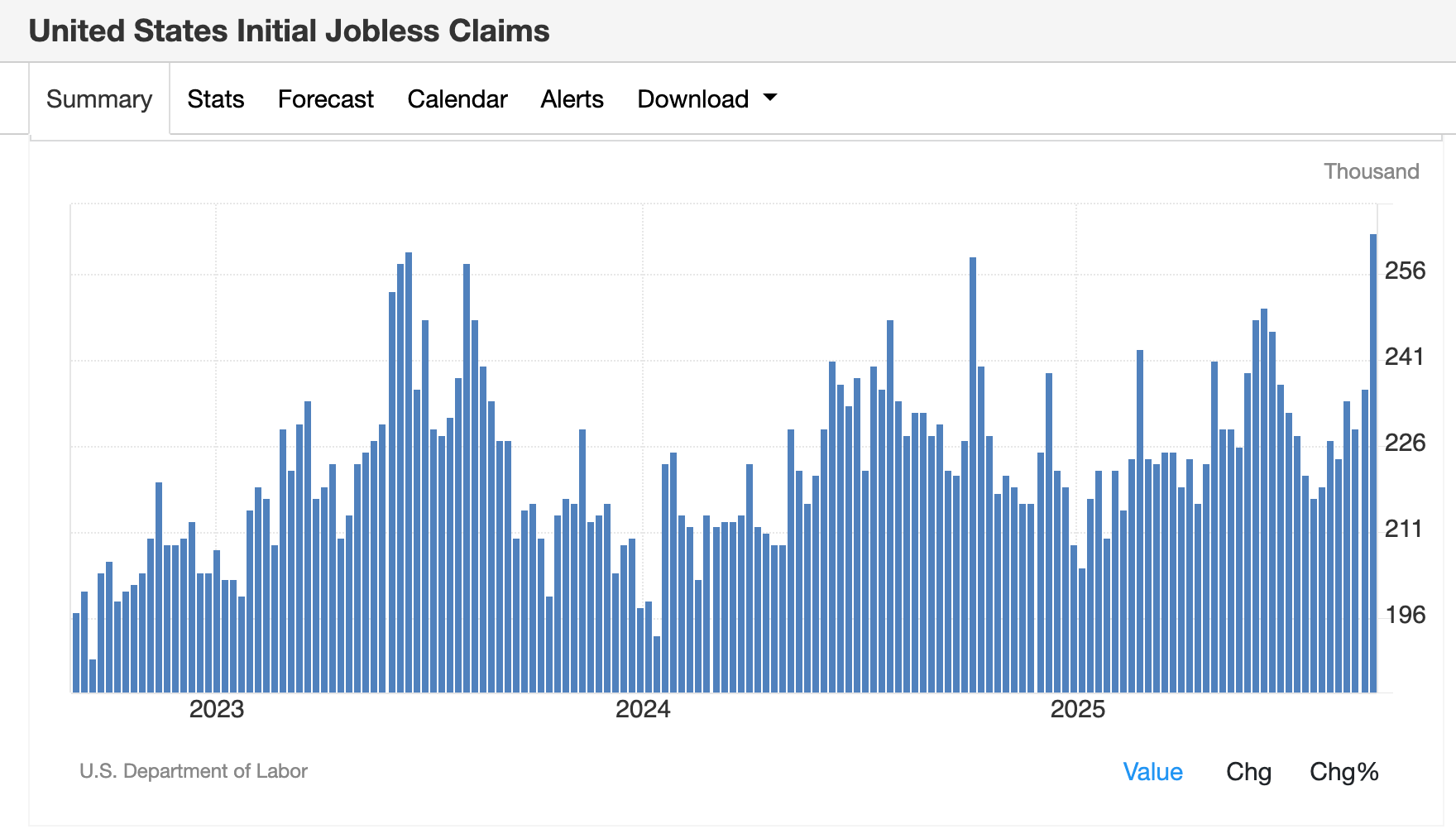
Higher inflation and fewer jobs are not great for the U.S. economy, so it’s no surprise that the word «stagflation» is starting to creep back into macroeconomic commentary.
Against this backdrop, bitcoin—considered a risk asset by Wall Street—continued grinding higher, topping $116,000 on Friday and almost closing the CME futures gap at 117,300 from August.
Not a surprise, as traders are also bidding up the biggest risk assets: equities. Just take a look at the S&P 500 index, which closed at a record for the second day on the hope of a rate cut.
So how should traders think about BTC’s price chart?
To this chart enthusiast, price action remains constructive, with higher lows forming from the September bottom of $107,500. The 200-day moving average has climbed to $102,083, while the Short-Term Holder Realized Price — often used as support in bull markets — rose to a record $109,668.
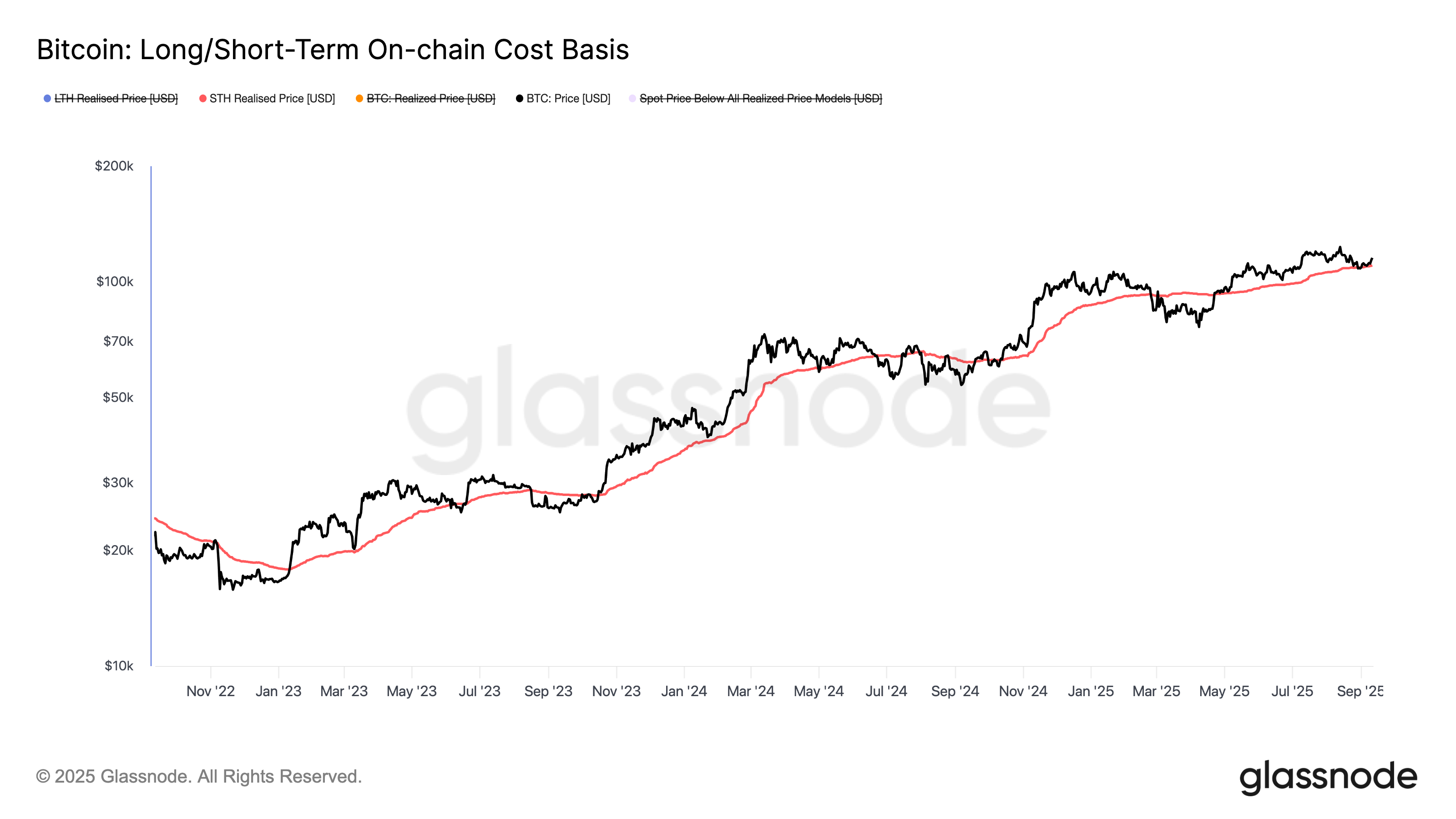
Bitcoin-linked stocks: A mixed bag
However, bitcoin’s weekly positive price action didn’t help Strategy (MSTR), the largest of the bitcoin treasury companies, whose shares were about flat for the week. Its rivals performed better: MARA Holdings (MARA) 7% and XXI (CEP) 4%.
Strategy (MSTR) has underperformed bitcoin year-to-date and continues to hover below its 200-day moving average, currently $355. At Thursday’s close of $326, it’s testing a key long-term support level seen back in September 2024 and April 2025.
The company’s mNAV premium has compressed to below 1.5x when accounting for outstanding convertible debt and preferred stock, or roughly 1.3x based solely on equity value.
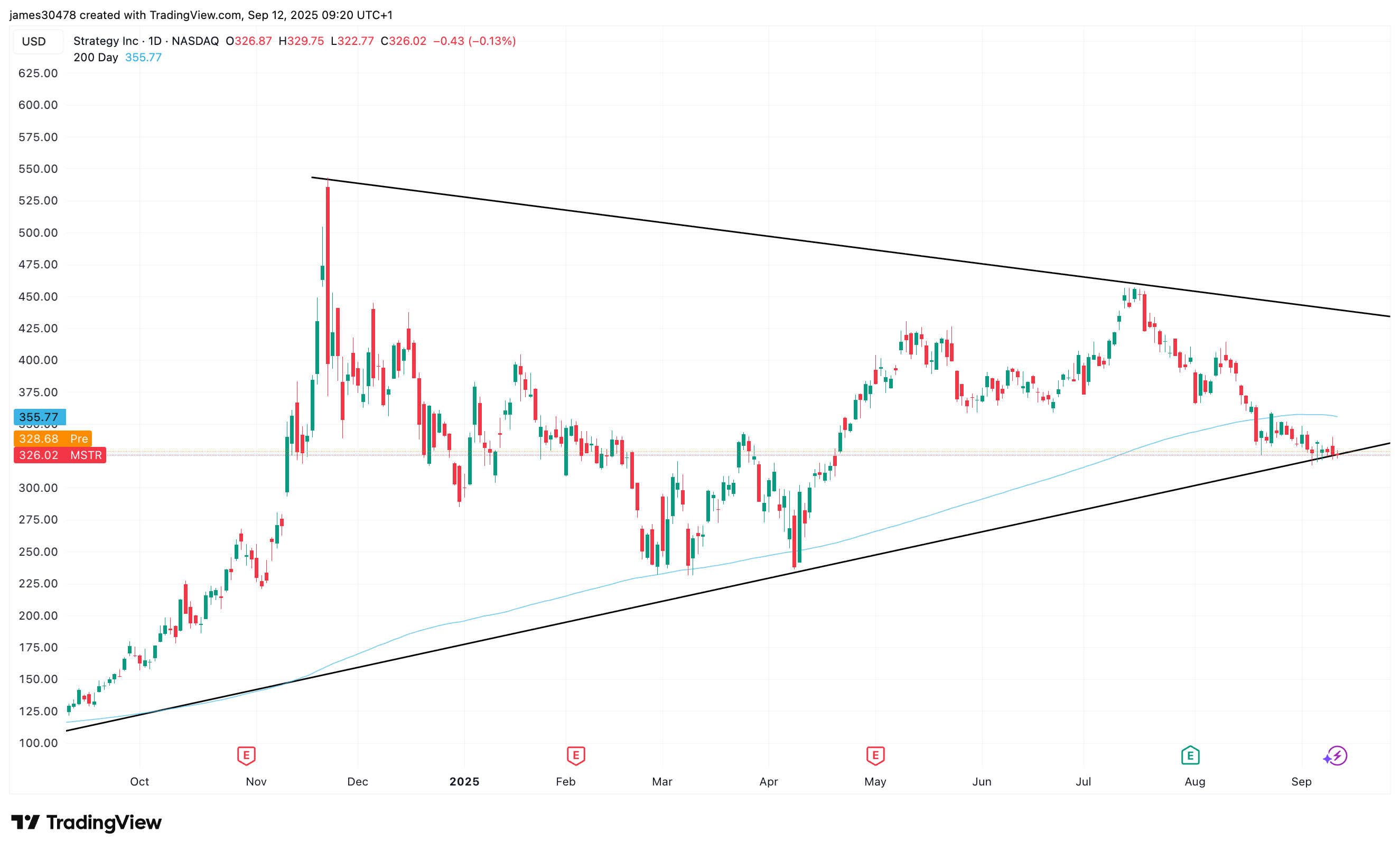
Preferred stock issuance remains muted, with only $17 million tapped across STRK and STRF this week, meaning that the bulk of at-the-money issuance is still flowing through common shares. According to the company, options are now listed and trading for all four perpetual preferred stocks, a development that could provide additional yield on the dividend.
Bullish catalysts for crypto stocks?
The CME’s FedWatch tool shows traders expect a 25 basis-point U.S. interest-rate cut in September and have priced in a total of three rate cuts by year-end.
That’s a sign risk sentiment could tilt back toward growth and crypto-linked equities, underlined by the 10-year U.S. Treasury briefly breaking below 4% this week.
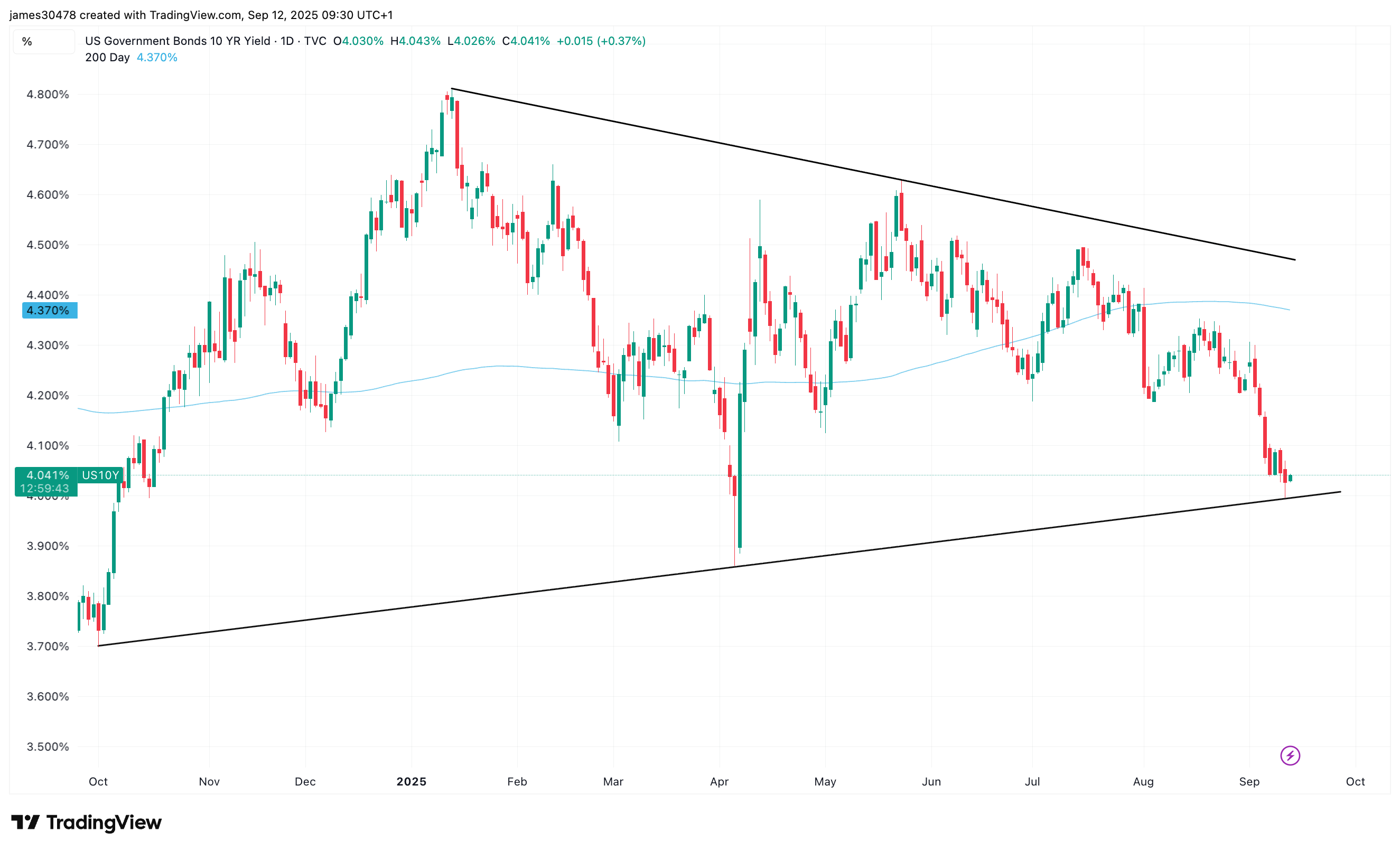
Still, the dollar index (DXY) continues to hold multiyear support, a potential inflection point worth watching.
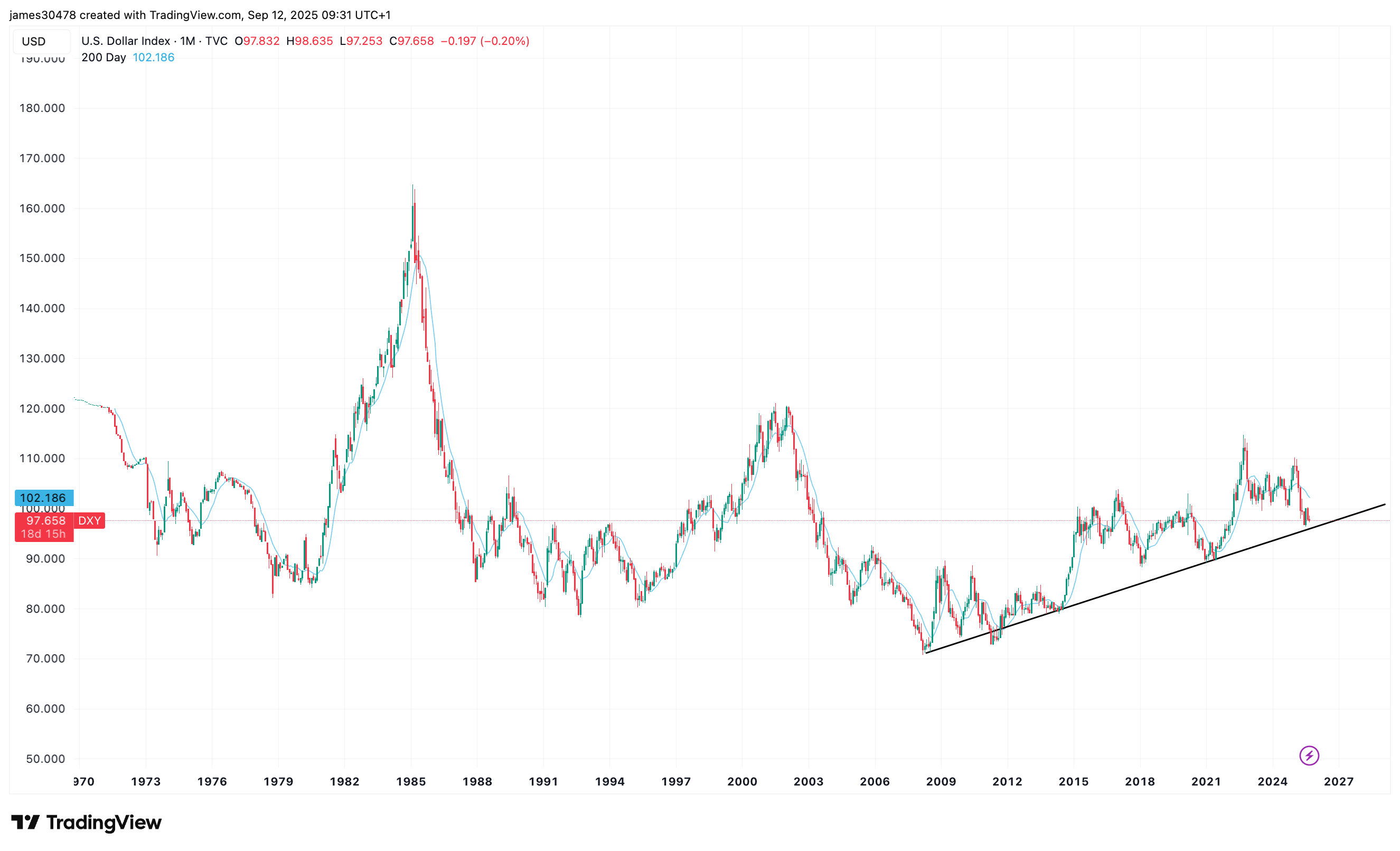
Uncategorized
Fed’s Sept. 17 Rate Cut Could Spark Short-Term Jitters but Supercharge Bitcoin, Gold and Stocks Long Term
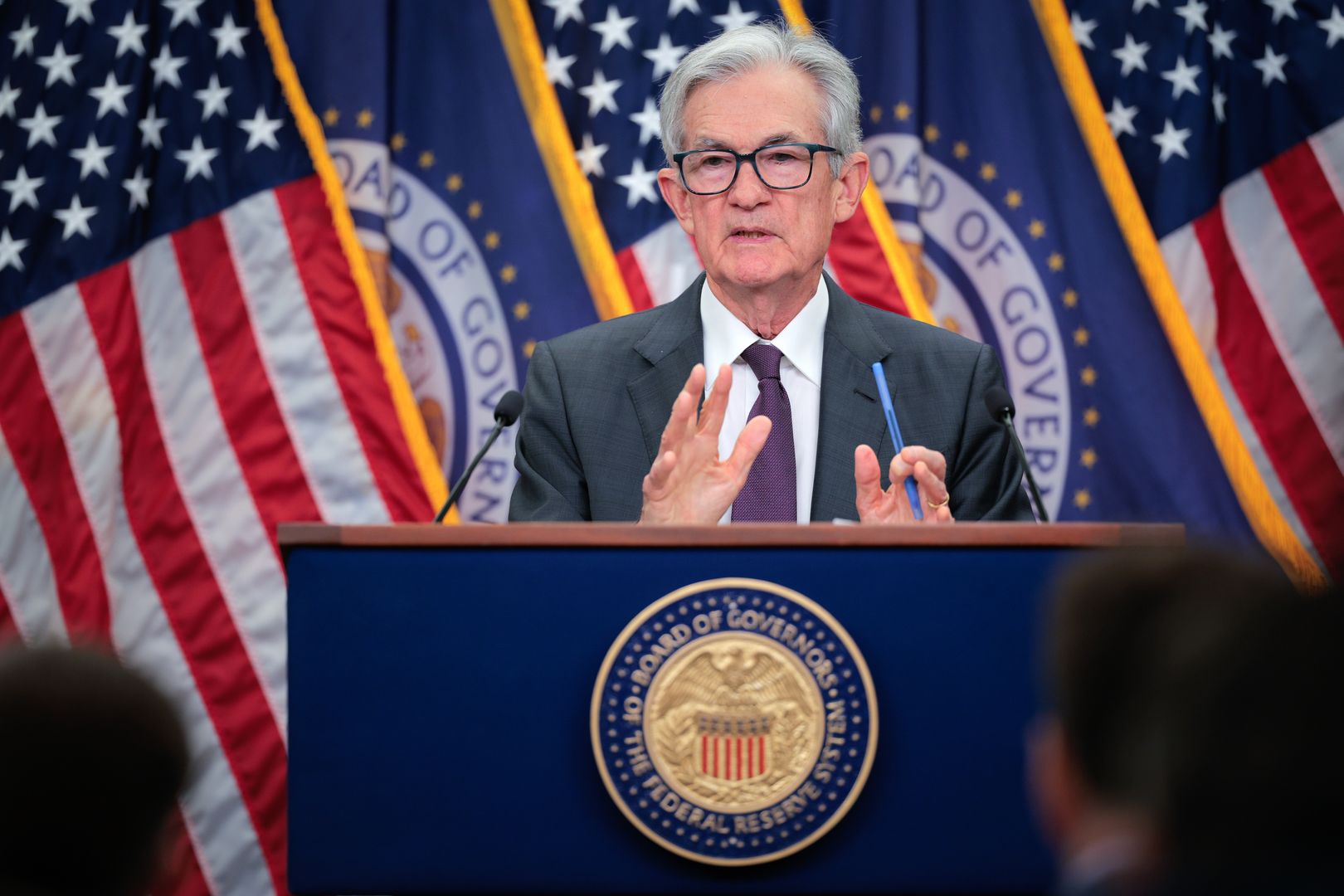
Investors are counting down to the Federal Reserve’s Sept. 17 meeting, where markets expect a quarter-point rate cut that could trigger short-term volatility but potentially fuel longer-term gains across risk assets.
The economic backdrop highlights the Fed’s delicate balancing act.
According to the latest CPI report released by the U.S. Bureau of Labor Statistics on Thursday, consumer prices rose 0.4% in August, lifting the annual CPI rate to 2.9% from 2.7% in July, as shelter, food, and gasoline pushed costs higher. Core CPI also climbed 0.3%, extending its steady pace of recent months.
Producer prices told a similar story: per the latest PPI report released on Wednesday, the headline PPI index slipped 0.1% in August but remained 2.6% higher than a year earlier, while core PPI advanced 2.8%, the largest yearly increase since March. Together, the reports underscore stubborn inflationary pressure even as growth slows.
The labor market has softened further.
Nonfarm payrolls increased by just 22,000 in August, with federal government and energy sector job losses offsetting modest gains in health care. Unemployment held at 4.3%, while labor force participation remained stuck at 62.3%.
Revisions showed June and July job growth was weaker than initially reported, reinforcing signs of cooling momentum. Average hourly earnings still rose 3.7% year over year, keeping wage pressures alive.
Bond markets have adjusted accordingly. The 2-year Treasury yield sits at 3.56%, while the 10-year is at 4.07%, leaving the curve modestly inverted. Futures traders see a 93% chance of a 25 basis point cut, according to CME FedWatch.
If the Fed limits its move to just 25 bps, investors may react with a “buy the rumor, sell the news” response, since markets have already priced in relief.
Equities are testing record levels.
Equities are testing record levels. The S&P 500 closed Friday at 6,584 after rising 1.6% for the week, its best since early August. The index’s one-month chart shows a strong rebound from its late-August pullback, underscoring bullish sentiment heading into Fed week.
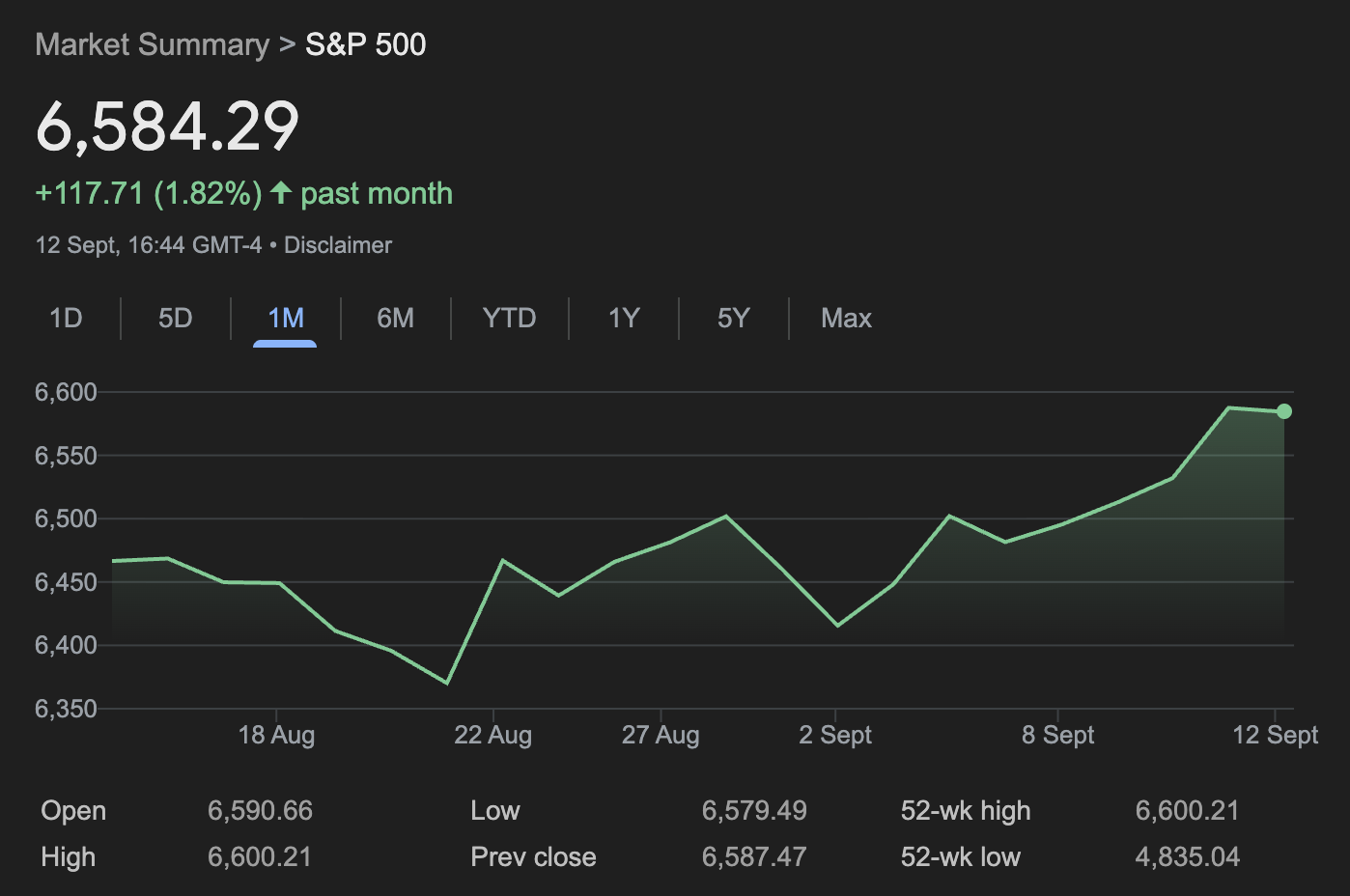
The Nasdaq Composite also notched five straight record highs, ending at 22,141, powered by gains in megacap tech stocks, while the Dow slipped below 46,000 but still booked a weekly advance.
Crypto and commodities have rallied alongside.
Bitcoin is trading at $115,234, below its Aug. 14 all-time high near $124,000 but still firmly higher in 2025, with the global crypto market cap now $4.14 trillion.
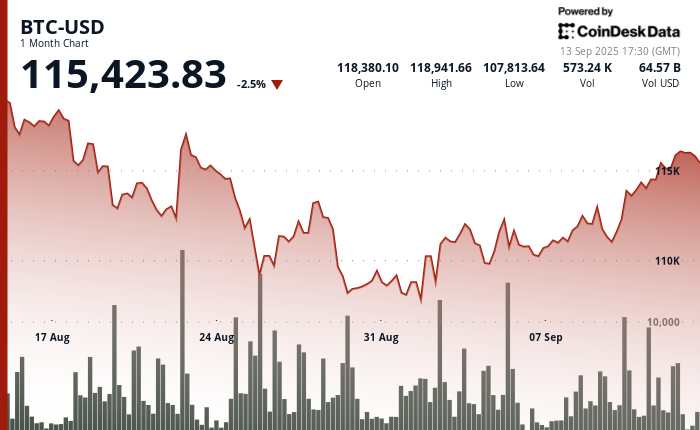
Gold has surged to $3,643 per ounce, near record highs, with its one-month chart showing a steady upward trajectory as investors price in lower real yields and seek inflation hedges.
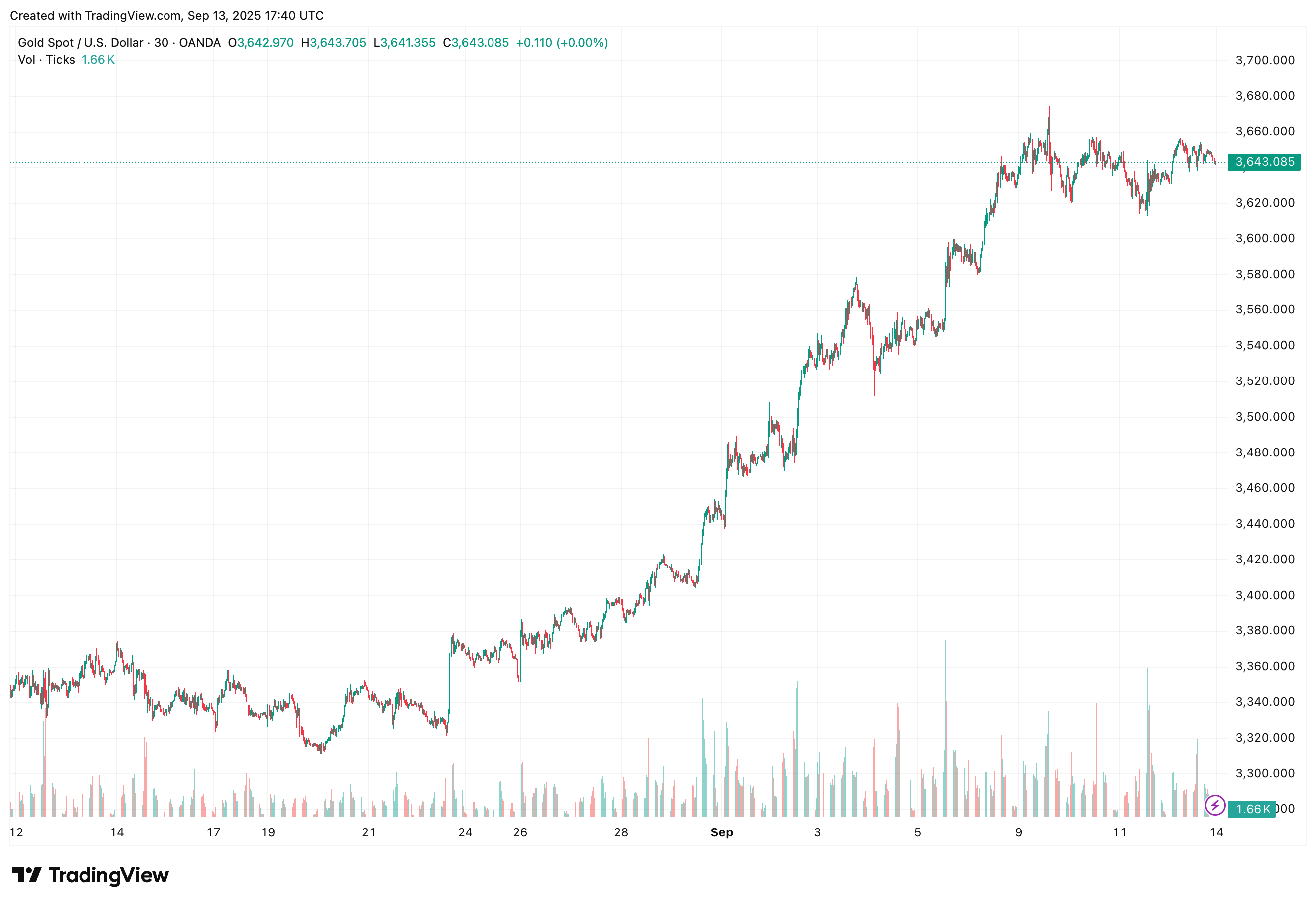
Gold has climbed steadily toward record highs, while bitcoin has consolidated below its August peak, reflecting ongoing demand for alternative stores of value.
Historical precedent supports the cautious optimism.
Analysis from the Kobeissi Letter — reported in an X thread posted Saturday — citing Carson Research, shows that in 20 of 20 prior cases since 1980 where the Fed cut rates within 2% of S&P 500 all-time highs, the index was higher one year later, averaging gains of nearly 14%.
The shorter term is less predictable: in 11 of those 22 instances, stocks fell in the month following the cut. Kobeissi argues this time could follow a similar pattern — initial turbulence followed by longer-term gains as rate relief amplifies the momentum behind assets like equities, bitcoin, and gold.
The broader setup explains why traders are watching the Sept. 17 announcement closely.
Cutting rates while inflation edges higher and stocks hover at records risks denting credibility, yet staying on hold could spook markets that have already priced in easing. Either way, the Fed’s message on growth, inflation, and its policy outlook will likely shape the trajectory of markets for months to come.
-

 Business11 месяцев ago
Business11 месяцев ago3 Ways to make your business presentation more relatable
-

 Fashion11 месяцев ago
Fashion11 месяцев agoAccording to Dior Couture, this taboo fashion accessory is back
-

 Entertainment11 месяцев ago
Entertainment11 месяцев ago10 Artists who retired from music and made a comeback
-

 Entertainment11 месяцев ago
Entertainment11 месяцев ago\’Better Call Saul\’ has been renewed for a fourth season
-

 Entertainment11 месяцев ago
Entertainment11 месяцев agoNew Season 8 Walking Dead trailer flashes forward in time
-

 Business11 месяцев ago
Business11 месяцев ago15 Habits that could be hurting your business relationships
-

 Entertainment11 месяцев ago
Entertainment11 месяцев agoMeet Superman\’s grandfather in new trailer for Krypton
-

 Entertainment11 месяцев ago
Entertainment11 месяцев agoDisney\’s live-action Aladdin finally finds its stars





